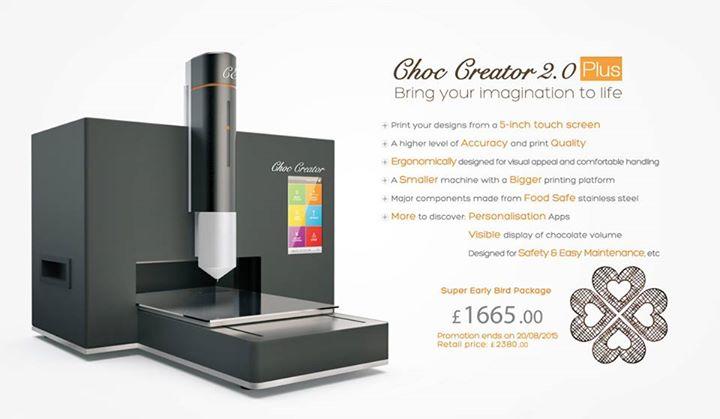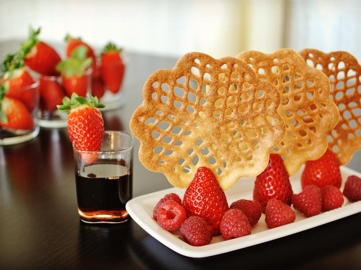The food printing space is still only in its formational stages, but there are early innovators who have actually made this science fiction concept into a reality. There are a number of food 3D printers you can buy right now, all of which are based on extrusion processes and are designed for printing with chocolate or food pastes.
The Focus 3D (€3,900) comes with ten food-safe and refillable cartridges, four nozzles in two different sizes, and access to paste recipes that include: chocolate ganache, meringue, savory dips, fruit, cookie dough, meat, celery-hazelnut, marzipan and icing. After early public events showcasing its 3D printer, the Dutch company behind the system, byFlow, continues to travel the globe to showcase its technology. It has also been recently listed as a leading and gender-diverse startup in the Netherlands by the country’s press.
 Photos of 3D printed dishes made by Jan Smink. (A) Celery Hazelnut Paste, (B) Berenhap 2.0 with curry paste, and (C) 3D printer cream cheese (available from byFlow).
Photos of 3D printed dishes made by Jan Smink. (A) Celery Hazelnut Paste, (B) Berenhap 2.0 with curry paste, and (C) 3D printer cream cheese (available from byFlow).Natural Machines may not have been able to launch its Foodini printer on Kickstarter in 2014, but the startup continued onward and is now selling the system for $4,000. The Foodini comes with five nozzles of varying sizes and five capsules, along with other accessories.
Like byFlow, Natural Machines offers pre-made designs and software for making your own 3D models. The company also provides some recipes to get started. For those who might need a little help getting off the ground with their Foodinis, the company also offers support packages that range from just one video phone chat with the company to Natural Machines whipping up ingredients, recipes and designs for you and presenting them to your staff on-site. The printers are already in the hands of customers, some of whom we’ll discuss in part three.
Spun out of the University of Exeter, Choc Edge developed the first commercially available food 3D printer. Designed specifically for chocolate, the £1,980 GBP Choc Creator 2.0 is the second generation of this flagship system. Despite the ups and downs of the 3D printing industry, Choc Edge is still in business and has been touring the world and visiting trade shows.
Founded in Germany in 2015, Print2Taste offers services as well as the Procusini printer, capable of printing chocolate, marzipan, pasta and fondant. Though prices aren’t available, Print2Taste does list €250.42 as the price for a separate chocolate 3D printer called the mycusini. Mycusini printers began shipping in November 2019.
There is also a Ukrainian company offering a chocolate 3D printer, though prices aren’t listed and social media activity ceased in early 2019.
Outside of dedicated food printing machines, it is possible to 3D print food paste using specialty extrusion nozzles. In particular, Structur3D offers a nozzle system that hooks up with existing FDM-style printers for printing with viscous materials. Zmorph also has a thick paste printhead for its printers and WASP offers a clay 3D printer that has been used to 3D print food products in the past. Any 3D printer capable of 3D printing viscous material, including extrusion-based bioprinters, should be able to deposit food pastes.
The reason we mention information like whether or not the companies mentioned here are traveling or have social media activity is that, like other 3D printing startups, there’s the possibility that the firms have fizzled out or may never have been real in the first place. Food 3D printing is obviously now a very niche segment with uses that are largely experimental.
With that in mind, if you really are interested in purchasing a food 3D printer, there are some brands to be skeptical of. For example, there is a firm called Mmuse, but we cannot yet find a dedicated website for the brand itself, only several food 3D printers for sale on 3DPrintersOnlineStore.com and on AliExpress. That doesn’t mean that their printers aren’t real, but that their existence is difficult to verify.
Similarly, a Createbot food 3D printer is sold on 3DPrintersOnlineStore.com, but none are listed on the Createbot website. A Chinese company called FoodBot also sells a food printer at the same online store. FoodBot has a website, but social media activity ceased summer of 2019. Another company that sells on Amazon and has current social media activity, but with machine renderings that look eerily similar to the Choc Creator that make this author suspicious is Wiiboox Sweetin.
As new companies sprout up all of the time and some sites publish listicles about food 3D printers, it’s important to be wary about any food 3D printer purchase. Even the verifiable manufacturers listed here could go out of business any day and may longer be able to provide support.
In the next part in our series, we’ll explore some of the ways food printers are being used and the research underway that could push the technology to the next level.
Join the discussion of this and other 3D printing topics at 3DPrintBoard.com.
Subscribe to Our Email Newsletter
Stay up-to-date on all the latest news from the 3D printing industry and receive information and offers from third party vendors.
Print Services
Upload your 3D Models and get them printed quickly and efficiently.
You May Also Like
3D Printing News Briefs, July 2, 2025: Copper Alloys, Defense Manufacturing, & More
We’re starting off with metals in today’s 3D Printing News Briefs, as Farsoon has unveiled a large-scale AM solution for copper alloys, and Meltio used its wire-laser metal solution to...
3DPOD 260: John Hart on VulcanForms, MIT, Desktop Metal and More
John Hart is a Professor at MIT; he´s also the director of the Laboratory for Manufacturing and Productivity as well as the director of the Center for Advanced Production Technologies....
3D Printing News Briefs, June 28, 2025: Defense Accelerator, Surgical Models, & More
In this weekend’s 3D Printing News Briefs, 3YOURMIND was selected to join an EU Defense Accelerator, and PTC has announced model-based definition (MBD) capabilities within Onshape. Finally, a study out...
EOS in India: AM’s Rising Star
EOS is doubling down on India. With a growing base of aerospace startups, new government policies, and a massive engineering workforce, India is quickly becoming one of the most important...




































